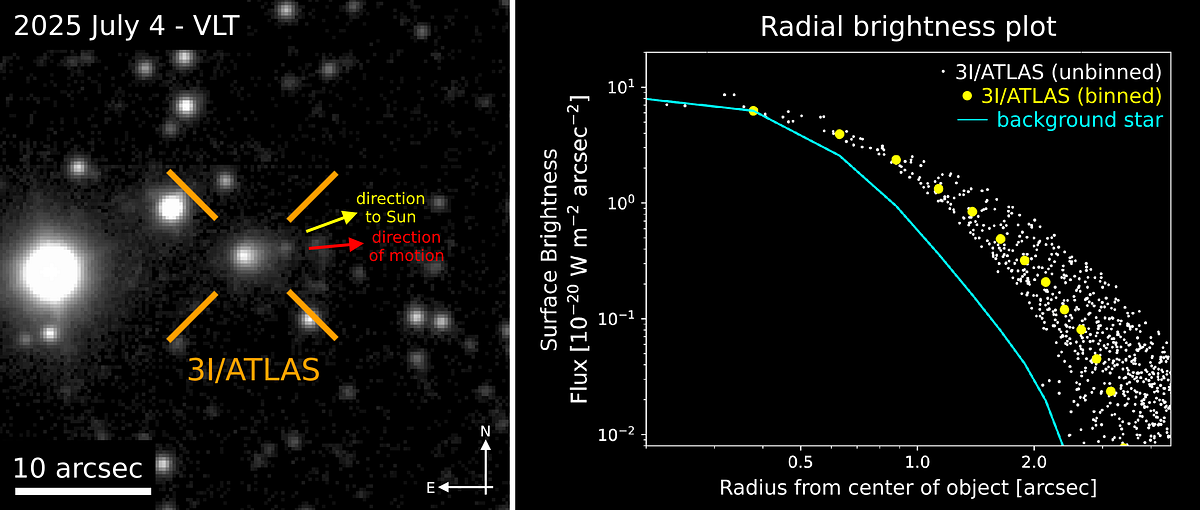Given its trajectory, the nucleus of the new interstellar object, 3I/ATLAS, cannot be resolved from Earth or space with our existing telescopes. If the nucleus is 10 kilometer in diameter, then its angular size would be about 10 milli-arcsecond at closest approach to Earth from a distance of about twice the Earth-Sun separation.
However, if NASA will choose to construct an optical interferometer on the Moon during its Artemis program, then we will be able to obtain resolved images of the nuclei of interstellar objects like 3I/ATLAS. The existing facilities of optical interferometry on Earth can only detect stars much brighter than 3I/ATLAS because of the limit imposed on their exposure time by atmospheric turbulence.
An interferometer on the Moon would avoid the phase shifts caused by atmospheric turbulence on Earth. With a baseline of several hundred meters and 1-meter mirrors operating at visible wavelengths, such a facility would reach the angular resolution and flux sensitivity needed to resolve the nucleus of 3I/ATLAS or similar interstellar objects in the future.
The recently inaugurated NSF-DOE Rubin Observatory in Chile is expected to discover a new interstellar object every few months, making a Lunar interferometer with these capabilities extremely useful in identifying the nature of these objects by imaging them. A resolved image can immediately inform us of whether an interstellar object is a natural rock of rank-0 or a technological spacecraft of rank-10 on the Loeb Scale.
High-resolution imaging can also be obtained from a camera that flies close to an interstellar object. For 3I/ATLAS, I proposed using the camera on Juno spacecraft, currently in orbit around Jupiter. If Juno had its initial fuel reservoir available, it could have intercepted the path of 3I/ATLAS when this object arrives closest to Jupiter on March 16, 2026. But even with a tenth of the initial fuel supply, Juno can get within 25 million kilometers from 3I/ATLAS, as I showed in the latest version of the paper I wrote with Adam Hibberd and Adam Crowl (accessible here) on this exciting opportunity. 3I/ATLAS is also expected to pass within a distance of 29 million kilometers from Mars on October 3, 2025. This would offer an excellent opportunity to observe 3I/ATLAS with the HiRISE camera currently in orbit around Mars, one of six instruments onboard the Mars Reconnaissance Orbiter. The aperture of this camera, half a meter in diameter, can potentially reach an angular resolution of a fraction of an arcsecond and resolve 30 kilometers per pixel at its closest distance from 3I/ATLAS. I encouraged the HiRISE team to use their camera and they responded favorably.
In future encounters with interstellar objects, humanity could be more ambitious. An array of spacecraft — each equipped with a camera — in orbit around the Sun, could potentially be ideal for obtaining resolved images of interstellar objects. The nearest spacecraft to an object’s path could intercept it and inform us about its nature. Constructing such an array would be an expensive project, but the political will to fund it as a Planetary Defense Program might exist as soon as humanity will receive a wake-up call from its first encounter with alien technology, as I discussed in a recent essay.
The best image we have so far of 3I/ATLAS, was obtained by the Hubble Space Telescope on July 21, 2025. It shows details at the angular scale of arcseconds, a thousand times worse than possible to resolve by an optical interferometer on the Moon. The Hubble image shows a compact fuzz elongated towards the Sun ahead of the motion of 3I/ATLAS with no evidence for a bright cometary tail pushed by radiation pressure in the opposite direction. As long as the scattering medium is optically thin, it would be possible to resolve the nucleus hidden within it.
We should aim higher in resolving interstellar objects. A picture is worth a thousand words.
ABOUT THE AUTHOR
Avi Loeb is the head of the Galileo Project, founding director of Harvard University’s — Black Hole Initiative, director of the Institute for Theory and Computation at the Harvard-Smithsonian Center for Astrophysics, and the former chair of the astronomy department at Harvard University (2011–2020). He is a former member of the President’s Council of Advisors on Science and Technology and a former chair of the Board on Physics and Astronomy of the National Academies. He is the bestselling author of “Extraterrestrial: The First Sign of Intelligent Life Beyond Earth” and a co-author of the textbook “Life in the Cosmos”, both published in 2021. The paperback edition of his new book, titled “Interstellar”, was published in August 2024.
